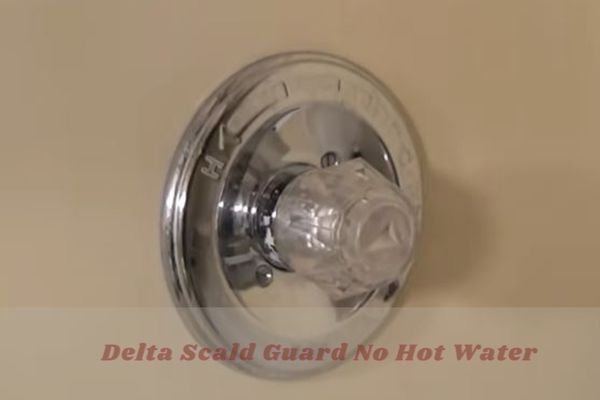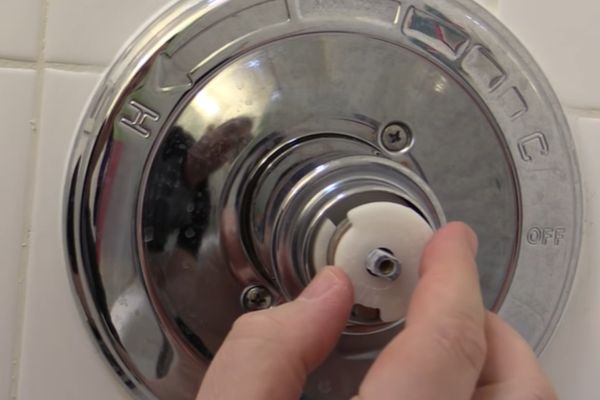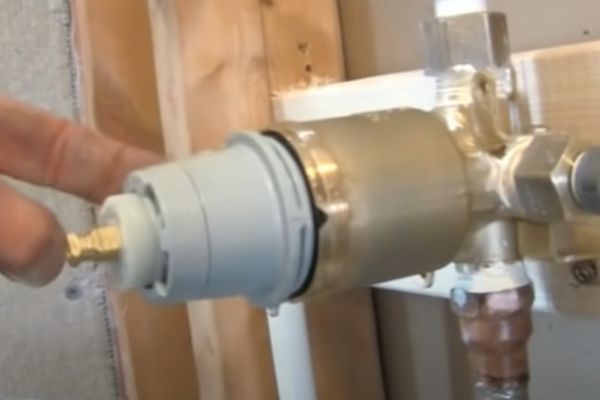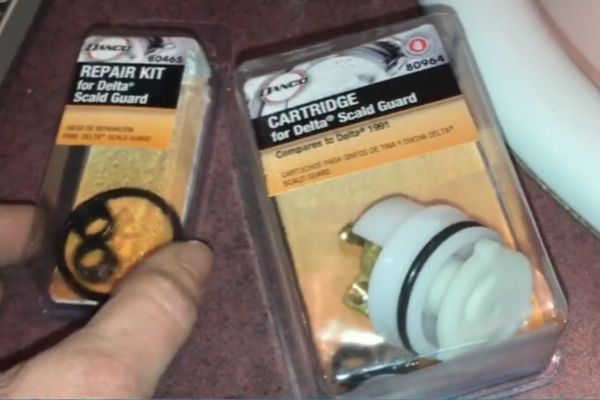The major reasons for Delta scald guard no hot water include the wrong adjustment of this device with the shower valve or the shower faucet cartridge is not properly installed.

So, first up, you have to adjust the scald guard to increase the water temperature. Plus, ensure the cartridge is correctly installed in the shower valve assembly.
If these two adjustments fail to resolve your hot water issue, the plumbing crossover might be the leading culprit.
At times, malfunctioning of the water heater will not let the shower water to reach the desired temperature.
Stay tuned till the end to get a well-proven solution guide regarding the Delta shower scald guard issue.
Table of Contents
Why Delta Scald Guard No Hot Water [Reasons + Solutions]
Before moving to the detailed troubleshooting parts, let’s have a glimpse at the below highlighted probable reasons and corresponding solutions.
Note: You can also read why the delta shower cartridge won’t go in and how to fix it.
| Probable Reasons | Possible Solutions |
Wrong Adjustment Of The Scald Guard | Access the scald guard and turn it counterclockwise to increase the water temperature. |
Incorrect Installment Of Shower Faucet Cartridge | Inspect the cartridge and make sure the marked “H” is on the left side of your shower handle. |
Worn Out Delta Scald Guard | Replace the faulty shower cartridge |
Mixing Valve Is Causing Plumbing Crossover | Consult a certified plumber to handle the issue. |
Water Heater Issues | Increase the water heater temperature check and replace the faulty heating element. |
What Is Delta Scald Guard Cartridge & How Does It Work
Almost all Delta shower series faucets are equipped with a special feature named scald guard. It is the safety device of the faucet, designed to allow you to increase or decrease the maximum water temperature of the faucet.
In short, you can change the water temperature even without adjusting your water heater thermostat. The device is also known as “rotational limit stops” The good thing is the device protects the water coming from the shower faucet from becoming too hot.
The feature is quite essential to protect you and your family from the risk of burns. It acts not only as a safety feature but also as an energy saver.
You are decreasing the water temperature and pressure through this device when you do not need the hot water. This lowers the energy costs for the most part.
Reasons For Delta Shower Not Getting Hot
The scald guard cartridge of the delta shower valve is enough to control the water temperature, ensuring your comfortable bath.
Yet sometimes, you might not get water at the appropriate temperature, from which you may face trouble.
But when you are aware of the actual reasons behind the issue with the proper solutions, you can lessen your struggles.
Here are all the responsive factors behind your delta faucet hot water not working and their effective solutions.
1. Wrong Adjustment Of The Scald Guard
The scald guard is an essential setting on your shower valve, which limits how much the shower handle will rotate to prevent burns/scalding.
If you are not getting hot water from the shower, the wrong adjustment of this safety measure equipment is the root culprit.
The scald guard needs to adjust with the cartridge, and for that, it will limit the maximum temperature of your shower. If it is not being calibrated correctly, it will fail to do so.
So, in the first troubleshooting step, you will need to take the scald guard out of the current place and set it up correctly.
No fear, follow the below instructions and adjust the scald guard to get the right temperature in your water.
How To Adjust Scald Guard On Delta Shower Faucet
First up, put a drop cloth over the shower drain and close the bathtub drain to prevent it from blocking off.

Then, locate the set screw opening along the side of the faucet handle. Take a hex key and rotate the screws counterclockwise. Remove the screws and detach the handle from the connection.
Now, grasp the trim plate and slide it off the valve stem. The shower cartridge will be exposed then.
You will see a small plastic disk there. Here you will find some writing with directions on the face of the scald guard. It will help to move the guard to adjust the water temperature.
Anyway, grab the scald guard and pull it out towards you. Turn the scald guard counterclockwise to increase the water temperature.
Once the adjustment is done, push it back into the cartridge. Make the notches on the scald guard fit between the slots in the cartridge.
Push the trim plate over the faucet cartridge. Reinstall the shower handle and tighten the screws. Our shower faucet will now give the right amount of hot water.
2. Incorrect Installment Of Shower Faucet Cartridge
If still the hot water is not coming out even after adjusting the scald guard, the problem is likely related to the adjustment of your shower cartridge. In your shower valve, the two lines for the hot and cold water are connected separately.

But during construction, if the lines are being swapped, you will not get hot water at the right temperature. Here, mistakenly the cartridge might be reversed inside the faucet handle while installing the shower.
For that, when you are turning on the faucet to the hot side, it’s using the cold water line.
So, in this stage, you need to adjust the cartridge and ensure the correct placement of this equipment inside the valve assembly. Let’s start:
Solutions:
Before starting, turn off the water supply. Then, unscrew the screws of the handle with an Allen wrench.
Then remove the shower handle from its place to access the shower valve. Remove the screws attached to the trim plate and valve assembly to detach the trim plate. The shower cartridge will be exposed.
You will find “H” written on one side of the cartridge. This mark is an indication of where the cartridge needs to connect to the hot water line used for hot water. The “H” should be placed on the left side of your shower handle.
Check and verify if the “H” of your cartridge is in the right spot. If not, pull the cartridge using a puller tool and adjust it correctly.
Finally, reassemble the trim plate. Attach the handles and tighten the screws. Now open your shower faucet on the hot side to see if this has fixed the problem. If not, follow the below section.
3. Worn Out Delta Scald Guard
Another leading reason why you are not getting enough hot water from the shower is worn-out delta scald guard. It might be loose that fail to sit with the shower cartridge.

The scald guard is a plastic part that is consistently exposed to higher temperatures. For this, the equipment may get worn out or break down completely.
Solutions:
De-assemble the shower valve assembly and check the scald guard if it is looking worn down. Notice the whole cartridge is well working condition.
Replace the complete cartridge for the delta scald guard. You will find cartridges for delta scald guard with a repair kit available in the market.
However, if replacing the cartridge yourself seems too much trouble, let someone professional handle the tasks.
4. The Mixing Valve May Be Causing A Plumbing Crossover
Sometimes, the issue might not be related to the scald guard but to the mixing valve that is connected to your shower. The core function of the mixing valve is blending the right amount of cold water with the hot, maintaining a good balance.
But when it starts mixing too much cold water with hot water or vice versa, the circumstance is known as plumbing crossover. Only the defective mixing valve allows the crossover of hot and cold water.
Due to plumbing cross-over, you will experience a water not hot enough issue from your shower. Not only that, it causes high energy losses as well.
Solutions:
To troubleshoot this issue, you need to detect the source of the plumbing crossover. That might seem difficult and time-consuming if you do not have so much plumbing knowledge and skills.
So, it will be best to hire experienced plumbers to deal with the plumbing crossover issue.
5. Water Heater Issues
If all the above adjustments fail to prove well and you are still struggling with the low water temperature issue, the problem might relate to the water heater.
It is the most obvious reason for fluctuating water temperatures. There could be several reasons for the malfunctioning of the water heater.
Some of the major ones are:
- Building up the lime scale, rust, and other deposits inside the water heater
- Incorrect temperature setting
- Faulty heating element
- Blockage in the vent pipes
- Tripped circuit breaker
- Leaking water heater
- Tripped or broken thermostat
- Insufficient-sized water hater
Solutions:
Take a look at the following information assigned below to get quick fixing methods for any water heater issue:
Problems | Solutions |
| Incorrect temperature setting | Access the temperature dial and turn it counterclockwise to increase the temperature. |
| Faulty heating elements | Inspect and replace the non-working heating elements. Contact any certified plumber. |
| Blockage in the vent pipes by nest, vermin or other debris. | Unclog the blockage from the vents and pipes. |
| Tripped circuit breaker | Flip the circuit breaker back and restart your water heater. Call an electrician if it is constantly tripping. |
| Tripped or broken thermostat | Locate the reset button on the thermostat. Push and release it to reset the thermostat. But if the thermostat keeps tripping, replace it. |
| Leaking water heater | Find the source of the water leaking and fix the issue |
| Build-up limescale in the water heater | To clean out the build-up of deposits inside the heater, it’s better to use a water heater descaling kit or lime descaler solution. Pour the lime descaler into the hater and allow it to sit for about 20 minutes. Then drain the water. |
| Insufficient-sized water hater | Test the efficiency of your water tank. Contact any professional to consult the matter. |
FAQs:
How do you adjust an anti-scald shower valve?
The adjustment method of the anti-scald valve is quite similar to the scald valve. Just access the valve and pull it from the connection. Then, turn it left to increase and right to decrease the maximum temperature of the water.
Can a mixing valve be adjusted?
Yes!! Definitely!! You can adjust the mixing valve according to your need. By rotating it counterclockwise, the water temperature will be increased. Turn clockwise to decrease it.
Should my shower faucet handle be on the left or right?
If your shower features with cross-shaped handle, you have to turn it left to open. Then turn the handle right to tighten.
Wrapping Thoughts
Well!! We are at the end point of our discussion about the delta faucet hot water adjustment. Throughout this article, we have given our level best to assemble each of the problematic factors behind the delta shower hot water issue with the correct methods.
We hope all have become informative enough for you, and now you can fix your delta scald guard with no hot water issue.
Don’t hesitate to let us know if you face any troubles while troubleshooting. We will come up with the best solutions.


About James
James founded HomeUpgradeLab & was sharing his experiences to fix issues related to bathroom and toilet fixtures & fittings. Read to know more about James Hill & how he started this blog.